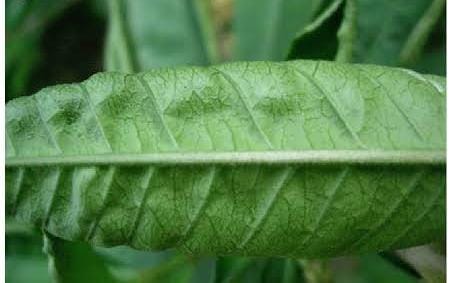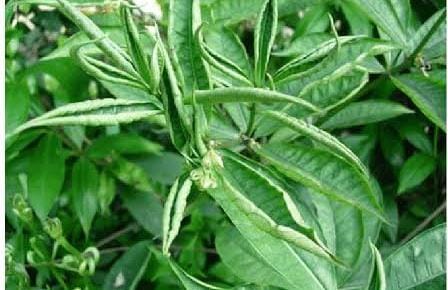Allamanda Creeper Plant
ALLAMANDA CREEPER is a tropical vine known for its showy yellow flowers. Plant in well-drained soil with full sun exposure. Keep the soil consistently moist during the growing season and provide support for the vine to climb. Pruning helps maintain a tidy appearance.
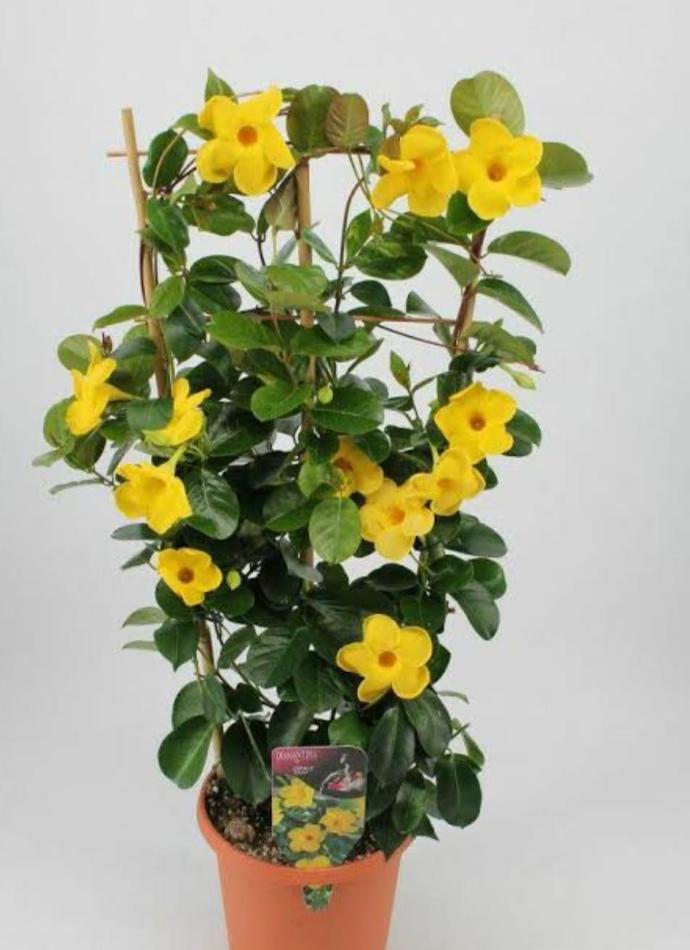
Habit
Vine/shrub
Height
Up to 20 ft
Growth
Fast
Soil
Well Drained, Fertile
Shade
Full Sun
Moisture
Moist
Edible
No
Medicinal
No
Origin
South America
Climatic Condition
Tropical, Humid
Temperature (°)
25-30°C
Humidity (%)
60-80%
Potting media
Peat+Perlite
Fertilizers
Balanced NPK (10:10:10)
Watering
Regular, Water deeply
Plant Weight
500-800 g
Flowering Time
Summer to Fall
Soil Ph level
6.0-7.5
Water Ph level
6.0-7.0
Soil EC
1-2 dS/m
Yield Per Plant
50-100 Flowers
NPK ratio
20:20:20
life Span
2-3 yrs
Health Benefits
Suggested Grow Media or Potting Mix ?
.40% potting soil, 30% compost, 30% sand
Suggested Fertigation/Fertilizers
Fertilize every 2 weeks with a high-potassium fertilizer.
Common Diseases and Remedies
Allamanda mosaic .
Leaves are curl and yellowing ,stunting growth.
Keep the trap to control vectors.
HEALTH BENEFITS
Allamanda creeper, also known as Allamanda cathartica, is a flowering plant that is native to tropical regions. While it's primarily grown for ornamental purposes, some parts of the plant have been traditionally used in herbal medicine. Here are some of the potential health benefits associated with Allamanda creeper:
- Antimicrobial Properties: Allamanda has been used for its antimicrobial effects. Some studies suggest that extracts from the plant have the ability to combat bacterial and fungal infections.
- Anti-inflammatory Effects: The plant is thought to have anti-inflammatory properties, which could help reduce swelling and pain in certain conditions.
- Pain Relief: Traditionally, the plant has been used to alleviate pain, including symptoms of arthritis and other inflammatory diseases.
- Laxative: The sap and leaves of Allamanda have been used as a mild laxative, helping to treat constipation.
- Antioxidant Activity: Some compounds found in Allamanda have been identified as antioxidants, which may help to protect cells from oxidative stress and reduce the risk of chronic diseases.
- Wound Healing: The plant is sometimes applied topically to wounds, cuts, or skin infections, as it is believed to aid in the healing process.
However, it's important to note that Allamanda is considered toxic in large quantities, and some parts of the plant (like the sap) can cause skin irritation. Always consult a healthcare professional before using it for medicinal purposes.
What Is An Allamanda Creeper Plant ?
Allamanda creeper plant, also known as Allamanda cathartica, is a tropical vine known for its vibrant yellow trumpet-shaped flowers. It belongs to the Apocynaceae family and is native to South America. Allamanda ivy plants are prized for their ornamental value and are widely grown in tropical and subtropical regions around the world. They need cool temperatures, full sun and well-drained soil to thrive.
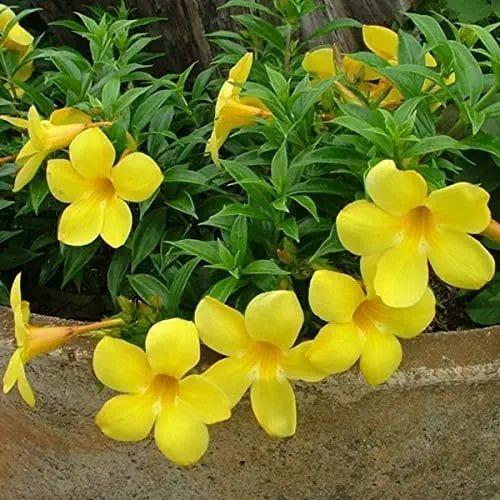
What Are The Different Types Of Allamanda Creeper ?
1. Allamanda cathartica
It is the most common species and is known for its yellow flowers.
2. Allamanda blanchetii
Also called purple yellow cicada, its flowers are purple.
3. Allamanda schottii
Known for its small orange-yellow flowers.
4. Allamanda neriifolia
The leaves of this species are narrower than other species and its flowers are yellow.
5. Allamanda williamsii
This plant, native to Brazil, is characterized by large yellow flowers with red hearts.

How to care for Allamanda Creeper ?
1. Location
Allamanda reptiles are generally raised outdoors in warm climates where temperatures do not consistently fall below 15°C (60°F). They thrive in full sun to partial shade and need plenty of room to stretch and grow. Yellow-bellied indoor plants may require more care than outdoor plants to provide adequate light and growing space. Regular pruning and maintenance is also important to maintain their size and shape indoors.
2. Sunshine
Allamanda creeper plant thrives in full sun or partial shade. They need at least 6 hours of direct sunlight a day to grow and bloom. In areas with strong sunlight, providing some afternoon shade can prevent sunburn on the leaves. However, too much shade may cause the flowers to decrease. When choosing a location to plant your Allamanda ivy, choose a location that receives full sun, especially in the morning when the sun is less strong. Indoors, place the plant near a sunny window where it receives adequate sunlight. Regular exposure to sunlight ensures good growth, lush green leaves and lots of flowers for your Allamanda ivy plant.
3. Soil
Allamanda ivy plant thrives in well-drained soil rich in organic matter. The best soil mix is one that retains water and drains excess water. You can create good soil for your Allamanda by mixing the soil with perlite, sand or peat moss to improve drainage. When planting or repotting Allamanda, make sure the pot or planting area is well-drained to avoid standing water, which can cause root rot. This soil mixture will provide a good growing environment for your Allamanda vines, encouraging healthy roots and good growth.
4. Hydration
Allamandas like constant moisture, but they do not like sitting in the soil. Water deeply, especially during the growing season when the topsoil becomes dry to the touch. They will need water more frequently in hot weather. Overwatering can cause root rot and other problems. Make sure the pot or planting area has enough water to prevent water from seeping through the roots . Morning watering allows excess water during the day to evaporate, reduces fungal diseases and promotes healthy growth. During cold weather or dormancy, reduce watering frequency to protect soil from water. Pay attention to humidity and water as needed during the warm season or period of active growth. Applying a layer of organic mulch around the base of your plant can help retain soil moisture and temperature, reducing the need for frequent watering. Try not to wet the leaves when watering as this can encourage fungal diseases. Instead, water directly at the base of the plant.
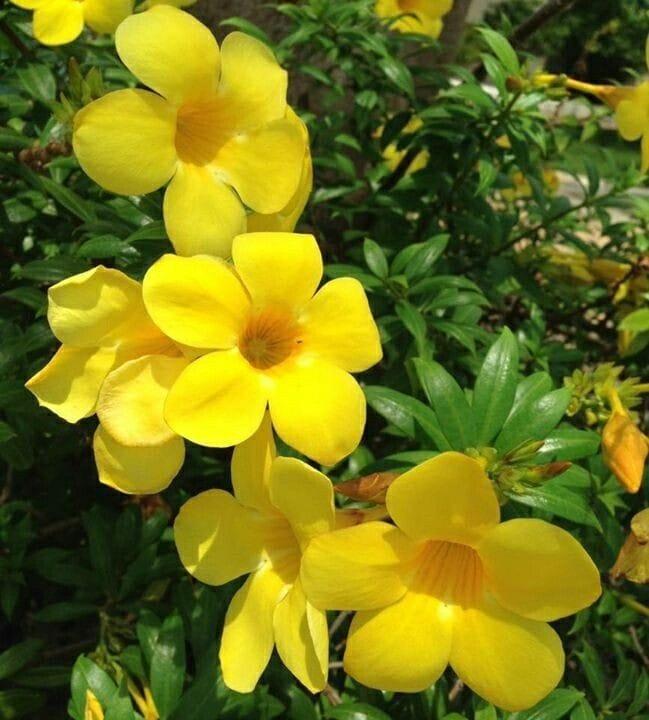
5. Nourishment
The best NPK (nitrogen, phosphorus and potassium) ratio for Allamanda ivy plants depends on many factors, including soil fertility, growth stage and overall plant health. However, the general advice for fertilizing your Allamanda is to use a balanced fertilizer with an NPK ratio of approximately 10-10-10 or 20-20-20. Chapter Stimulates leaf growth and general plant vigour. It is important in promoting lush green foliage of Allamanda plants. Promotes root growth, flowering and fruiting. Phosphorus is required to promote flowering in Allamanda plants. Improves overall plant health, including resistance to disease and stress. Potassium also plays a role in flowers and fruits.
6. Issues
Allamanda ivy plants can have many problems, including pests, diseases and environmental stress. Here are some common problems and how to fix them. Yellowed leaves can indicate a number of problems, including overwatering, waterlogging, nutrient deficiency, or root rot. Evaluate your plant's watering pattern, soil moisture and nutrient levels to determine the cause of yellowing leaves and adjust care accordingly. Yellow flowers will not bloom if they do not receive enough sun, are not fertilized enough, or are not pruned too much. Remember that plants receive at least 6 hours of sunlight per day, fertilize evenly throughout the growing season, and avoid excessive pruning, especially during the flowering period. Allamanda can be affected by environmental stresses such as heat, drought or rain. Protect your plants from the cold by moving them indoors or providing protection against frost during the winter months. Maintain regular watering and do not allow the soil to dry out, especially in hot weather.
What are the Benefits of Allamanda Creeper ?
Allamanda creeping plants have many advantages, both beautiful and practical: Allamanda plants produce large flowers that are bright yellow, golden yellow or pink, depending on the species. These flowers add beauty and colour to the garden, landscape and interior, increasing its appeal. Allamanda's bright flowers attract pollinators such as bees, butterflies, and hummingbirds, contributing to the biodiversity and ecosystem health of the surrounding area. Allamanda vines are trained to climb and cover trellises, fences, or walls; This provides a privacy screen in an outdoor environment. When in bloom they create a lush green background while still adding a splash of colour. In some cultures, some parts of the Allamanda plant are used for their medicinal properties. But be careful because the plant contains toxins that can be harmful if eaten. Overall, allamanda vines are valued for their ornamental beauty, their versatility in landscaping, and their aid to pollinator habitats, making them a popular choice for gardens and outdoor spaces.
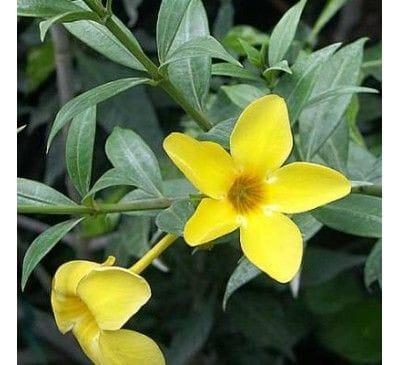
FAQs About Growing Allamanda Creeper
1. How to maintain allamanda creeper?
Allamanda climbing plant involves many important tasks to ensure its health, growth and appearance. Here's how you can care for your yellow-bellied parrot: Regular pruning is important to maintain plant size and shape, encourage bushy growth, and remove dead or diseased branches. Prune allamanda plants after they bloom to encourage new growth and maintain a beautiful appearance. Keep the soil moist at all times, but never wet. Water deeply, especially in hot weather or when the top layer of soil becomes dry during the growing season. Adjust watering frequency according to environmental conditions and plant needs. Provide Allamanda plants with a balance of fertilizer throughout the growing season (spring and summer) to provide essential nutrients for good growth and flowering. Follow fertilizer manufacturer's instructions for application amount and frequency. Provide a trellis, trellis or other support for Allamanda vines to climb and stretch. As the vines grow, train them to support structures that will encourage growth and prevent them from spreading. Apply a layer of organic mulch around the base of the plant to help retain moisture, reduce weeds, and maintain soil temperature. Keep mulch away from plants to prevent rot.
2. What are the uses of Allamanda ivy plant?
Decorative , Box Gardening , Medical use.
3. Can I grow allamanda creeper indoor?
Yes, you can raise Allamanda reptiles indoors, but there are some important things to remember: Allamanda thrives in full sun or partial shade. Indoors, place your Allamanda near a south-facing window that will receive at least 6 hours of direct sunlight per day. Additional grow lights can be used to provide additional light if necessary. Since Allamanda ivy plants can grow large, make sure there is enough space for the plant to grow and spread. Consider using a trellis or support to guide the vines and prevent them from spreading. For indoor yellow bellied plants, use a well-drained potting mix rich in organic matter. A mixture of potting soil, perlite and peat moss works well to provide good drainage and aeration to the roots. Regular pruning is necessary to maintain the size and shape of the plant and prevent it from becoming too leggy. Prune plants after flowering to encourage bushier growth and remove dead or damaged branches.
4. what is the best pot for Allamanda creeper plant ?
Choose a pot made of durable and weather-resistant materials such as plastic, ceramic or terracotta. Plastic pots are lightweight and retain moisture well, while ceramic and terracotta pots provide good aeration for the roots but require more watering. Consider the weight of the pot, especially if you plan to carry the pot frequently. Plastic pots are lighter and easier to use than ceramic or clay pots, which can be heavy, especially when filled with soil. Choose a pot that complements your indoor or outdoor space and enhances the visual appeal of your Allamanda plants. Choose a colour and style to match your existing decor or add a beautiful touch to your outdoor space.
5. From where can I buy Allamanda creeper plant?
Depending on your location and preferences, you can buy Allamanda reptiles from many places: Visit a local preschool or preschool in your area. They often bear a variety of plants, including Allamanda creepers, especially during the growing season. Many online plant stores and nurseries offer a wide selection of plants that can be delivered directly to your door. Look for reputable online stores with good reviews and ratings.
